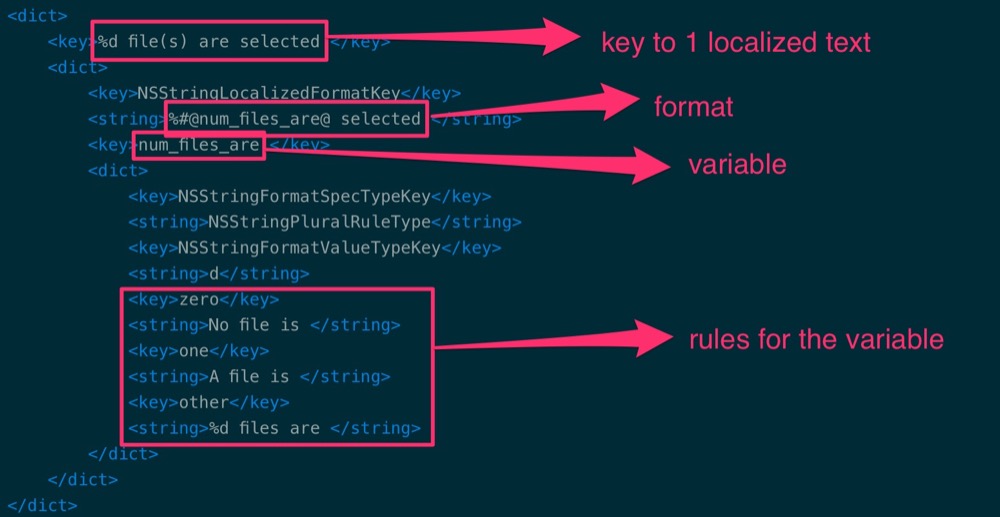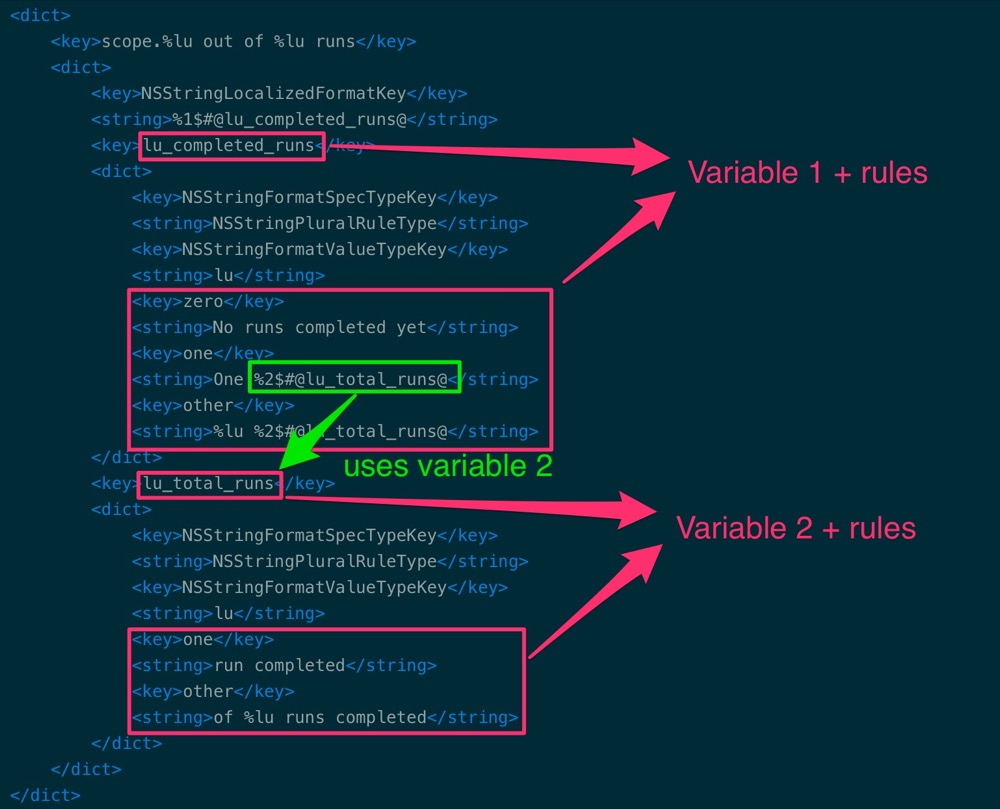When I wrote everything about iOS localization, I covered on plural support, but was brief.
This post I will explain the use of the powerful .stringsdict with a simple use, explaining the basics, then an advanced use. Lastly I will try to explain some magic under the hood.
Simple Case
It is easier to use an example and explain.
<?xml version="1.0" encoding="UTF-8"?>
<!DOCTYPE plist PUBLIC "-//Apple//DTD PLIST 1.0//EN" "http://www.apple.com/DTDs/PropertyList-1.0.dtd">
<plist version="1.0">
<dict>
<key>%d file(s) are selected</key>
<dict>
<key>NSStringLocalizedFormatKey</key>
<string>%#@num_files_are@ selected</string>
<key>num_files_are</key>
<dict>
<key>NSStringFormatSpecTypeKey</key>
<string>NSStringPluralRuleType</string>
<key>NSStringFormatValueTypeKey</key>
<string>d</string>
<key>zero</key>
<string>No file is</string>
<key>one</key>
<string>A file is</string>
<key>other</key>
<string>%d files are</string>
</dict>
</dict>
</dict>
</plist>
The code to use:
let numberOfFiles = 1
let format = NSLocalizedString("%d file(s) are selected", comment: "")
let localizedString = String(format: format, numberOfFiles)
There are 2 distinct calls here:
- You need to get the “format” using the macro
NSLocalizedString. In the code above, the variable format will be%#@num_files_are@ selected. Note: This is not yet localized, unlike the usual localization! - Init
Stringwith this format and the actual arguments, and you will get the localized string.
Basics of the XML:
%d file(s) are selectedis simply a key to refer to this 1 string to localize. But it is NOT necessary to have the%din the key. You can rename the key as egfilesand it will work. Having the%dis more of a good convention, telling us 1 number should be provided as an argument.%#@num_files_are@ selectedis known as a format, which is made up of 1 variablenum_files_areand the text “ selected”.num_files_areis a key (to the variable) with a dict to explain the rules:NSStringPluralRuleTypeis plural rules (there could be others in the future)NSStringFormatValueTypeKeydescribe what type of argument works with this variable eg.dforIntzerois a rule. When the argument is 0, it will use “No file is” to replace the variablenum_files_are, therefore finally forming “No file is selected”oneis another ruleotheris another rule. This time, it will use “%d files are”, and the argument is used here, finally forming eg. “2 files are selected”

Advanced Case
I like the example used in objc.io:
<?xml version="1.0" encoding="UTF-8"?>
<!DOCTYPE plist PUBLIC "-//Apple//DTD PLIST 1.0//EN" "http://www.apple.com/DTDs/PropertyList-1.0.dtd">
<plist version="1.0">
<dict>
<key>scope.%lu out of %lu runs</key>
<dict>
<key>NSStringLocalizedFormatKey</key>
<string>%1$#@lu_completed_runs@</string>
<key>lu_completed_runs</key>
<dict>
<key>NSStringFormatSpecTypeKey</key>
<string>NSStringPluralRuleType</string>
<key>NSStringFormatValueTypeKey</key>
<string>lu</string>
<key>zero</key>
<string>No runs completed yet</string>
<key>one</key>
<string>One %2$#@lu_total_runs@</string>
<key>other</key>
<string>%lu %2$#@lu_total_runs@</string>
</dict>
<key>lu_total_runs</key>
<dict>
<key>NSStringFormatSpecTypeKey</key>
<string>NSStringPluralRuleType</string>
<key>NSStringFormatValueTypeKey</key>
<string>lu</string>
<key>one</key>
<string>run completed</string>
<key>other</key>
<string>of %lu runs completed</string>
</dict>
</dict>
</dict>
</plist>
The localized string requires 2 arguments:
let completedRuns = 1
let totalRuns = 2
let format = NSLocalizedString("scope.%lu out of %lu runs", comment: "")
let str = String(format: format, completedRuns, totalRuns)
Let’s look at the output first.
Completed runs Total Runs Output
------------------------------------------------------------------
0 0+ No runs completed yet
1 1 One run completed
1 2+ One of x runs completed
2+ 2+ x of y runs completed
It is an advanced use because the output depends on both the arguments.
The biggest difference is that this time, there are 2 variables, each with their set of rules, and one variable refer to another!

- The format is
%1$#@lu_completed_runs@, which uses 1 variablelu_completed_runs(yes, just 1 variable in the format is okay), and that it is the first argument as specified by the1$ - In some of the rules for
lu_completed_runs, it uses a format%2$#@lu_total_runs@, which uses another variablelu_total_runs. This variable is the 2nd argument as specified by the2$. - The rules in
lu_total_runswill produce part of the text forlu_completed_runs
There is some recursive lookup going on :)
The Puzzling String
Let’s look at the simple case again to explain something strange that goes on.
let format = NSLocalizedString("%d file(s) are selected", comment: "")
// format is "%#@num_files_are@ selected"
let str = String(format: format, 1)
// str is "1 file is selected"
If you have been using String(format:_:), you know it can format the string and replace with the arguments.
But it is hard to digest for the format %#@num_files_are@ selected, a mere string.. How does a mere string have access to the rules in stringsdict?
The string %#@num_files_are@ selected is not a mere string. It knows the rules, for a particular locale.
Try this and it will NOT work:
// let format = NSLocalizedString("%d file(s) are selected", comment: "")
let format = "%#@num_files_are@ selected"
let str = String(format: format, 1)
This proves that the macro NSLocalizedString, which return a String via Bundle.localizedString, is not a pure string.
I am puzzled and I hope someone can explain.
I can see NSString use CFStringCreateWithFormatAndArguments. In CFString, it mentions stringsDictConfig. It seems like the system refer to this dictionary to look up the rules and format the final string.